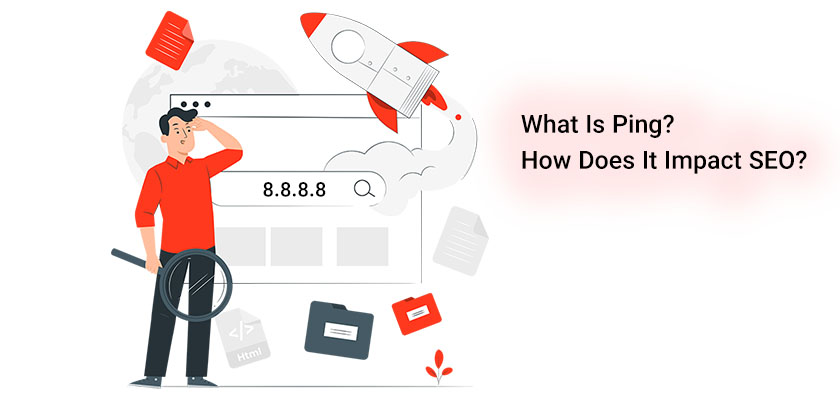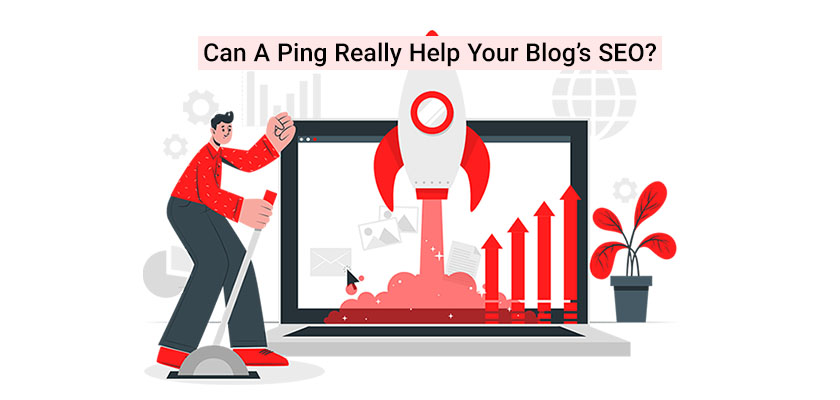
We generally use Ping Submission as an Off Page SEO technique for indexing our links. It’s a search-related off-page method that alerts you to new web posts, blog posts, and backlinks. This method allows you to crawl and index the most recent backlink. First, you must upload your content to these websites before you can begin to work.
It’s a breeze to utilize. Pinging your backlinks is primarily used for the purpose of speeding up their ranking by search engines you’re trying to target, which allows them to transfer link equity faster than they normally would. Pinging a website is simple; just type in the URL to the webpage you want to ping as well as its title, then click the submit or ping button to initiate the process. In this article, we’ll go over what is pinging and how ping affects SEO.
What Is Pinging?
Pinging is a method for sending an electronic message to search engines and other websites that you’ve added new or updated information on your site. The ping informs websites, such as feed aggregators, search engines, social networks, and users, that you have updated information on your website.
What Is Ping Submission?
There are numerous SEO tools available, which include Ping Submission. This is a method of sending automated alerts to engine spiders. They are kept informed on the progress of crawling. A lot of people are getting knowledge of the significance of Ping submission in SEO today. So how ping affects SEO? Pinging submission helps webmasters get the number of people who visit their site because of the backlinks created.
It could help you gain higher rankings on organic search results, which is the objective of SEO marketing. Thus, many SEO specialists are investing time in learning about the art of pinging so that they can increase their reach and reach. There are a variety of pinging websites that will send your blog’s URL or URL address of your website. It is not recommended to send this URL with multiple pinging services more than 4 or 5 times. It won’t bring any benefit.
What Does Ping Mean in SEO?
When it comes to SEO, the ping isn’t directly affecting your ranking, which means that there’s nothing in Google’s algorithm that states “the more times a post is pinged, the higher it should rank”. Google strives to eliminate rankings factors that could be easily targeted by webmasters desperate to achieve high rankings. And that was easy to manipulate a long time ago (with some modest effect). These days, they’re gone.
However, your search engine rankings can be affected by the presence of more websites all over the world that link to your website. And the pings could increase the number of websites that find your content which can open the way to other blogs or websites to take note of or feature your content and provide you with the opportunity to share your link.
Therefore, there are some possible benefits from an SEO standpoint. However, the primary goal of pinging is to ensure that your latest content is discovered more quickly, resulting in more visitors. Claim a powerful VPS hosting with high speed to improve your website quality and make more visitors to stay and explore more in your website.
Can A Ping Really Help Your Blog’s SEO?

The latest scheme to increase traffic speed for results from search engines has come into effect, with ping notification sites being flooded with updates even if your blog isn’t recently updated. It’s a question of whether this or a variant of it works? If not, from where did the idea originate?
First, let’s talk about the bad news. Pinging sites such as Yahoo as well as Google every half-hour for days or even weeks to inform users of updates that haven’t been released is nothing more than clogging the system. This is known as spam-pinging and has been in existence since 2002.
If you’ve never changed your blog’s content or pinging the latest updates of websites that aren’t actual blogs, it’s making it harder to be listed on these websites. In the short term, you may be removed from sites such as Yahoo, even though it’s not an official policy for them to eliminate websites due to spam-pinging.
Yes, not all sites which have lists of recently updated sites you can ping on are configured to prevent pings from websites that aren’t up-to-date. But they’ve come up with ways to block certain websites and users. It’s just an issue of the time.
In the unlikely scenario that you find a solution to do this for a short period, you’re making yourself vulnerable to being removed as fast as a few hours in some instances. If this approach does not work, what tools are available to assist you in flooding directories? What if you buy VPS hosting and launch a brand new website and want your blog posts to be on the search engine results page? Let’s examine the situation from a rational perspective.
At the beginning of 2004, some adult websites could create a variety of fake blog websites, specifically blogspot.com. They’d noticed that the hyperlinks leading to them from these sites improved their page ranking in Google and their position in search results.
While Google has gotten wise to its mistakes and closed the loophole by the fall of this year, a number of legitimate blogs have discovered that they still enjoy good rankings for some of the keywords that are easy to acquire. People mistakenly think their blog posts are posted on Weblogs.com and/or on the most updated blogger pages, which are updated several times daily.
When they noticed that, at times, they were pinged at the exact time they published, they realized there was a connection between pings and improved results on search engines.
They’re also not entirely incorrect. This is considered a method on how to fix high-ping issues; there’s the possibility of a parallel. However, a parallel isn’t the reason behind it. It’s only one part of the connection between blogs and getting higher results on Yahoo, Google and MSN.
Their frequent updates have some connection to their ranking, sure. However, it’s not the sole factor in ensuring they are spidered. And if your blog doesn’t have the right configuration to benefit from the visits from search spiders, it won’t be listed.
In order to get an understanding of how you can obtain the same results on your website, you must take a look at the larger overall picture. Spam-pinging will not be the solution, and as I’ve stated in my previous posts, there are safer, more ethical, and faster methods to achieve this.
But even if these websites appear on public lists of ping notifications or other websites that keep track of blog posts, this doesn’t mean that you can ping them without updating your website.
It doesn’t necessarily mean that websites that are authentically regularly updated and sent pings will be listed within Google, Yahoo or MSN because they are regularly updated.
The good news is that you don’t have to flood the ping sites in order to be noticed. It’s an unnecessary waste of time and could be a damaging one.
The best strategy for the moment is to keep working to improve your organic search engine rank by blogging and basic search engine optimization, and a common sense approach to regular updates.
In fact, it is true that there is a legitimate method to be a part of search engines and gets top rankings using blogs. However, it’s not about the amount. It’s more about the timing, supply and demand. However, explaining the process requires an amount of depth and space that’s not readily available.
What Are the Benefits of the Ping Submission?
Pinging a website is an effective method to stay informed of the backlink crawler count on your blog or site. There are many other advantages to getting the hang of the concept of a ping submission. There are a few of them:
- It aids in increasing the indexing of sites
- This can help improve the position on Search Engine Results Pages (SERP)
- This is a secure and secure method for SEO
- It assists in increasing the domain authority
- You are allowed to make as many pings as you want at a time
- This is an excellent method to generate quality backlinks
Conclusion
The pinging “can” help with exposure for blog posts that are new, especially if you buy VPS hosting and start publishing blog posts on your brand-new website. However, if you’ve had some success with it, that’s great. Many blogs or search engines discover your blog posts through indexing “spiders” (also called bots or robots). Pinging is a way to increase the speed of that process.










Leave a Reply